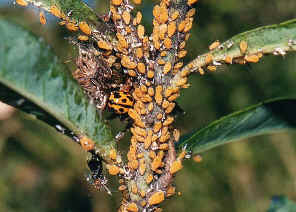|
|
Aphids - Family Aphididae
Aphids are small to very small in size. They are soft body and usually wingless. There are the winged form with very thin membranous wings. Usually their body is in pear-shaped. Most species have a pair of posterior at the abdomen.

Like most other bugs they are sap-sucking insects. Unless aphid colonies are allowed to grow to a large side, the feeding activity of a few aphids will cause little damage. The real problem is if the aphids carry a plants virus which infected the plants.
Aphids are different from most other insects in two ways. Firstly, all aphids in the colony are female and reproduce without the male. Secondly, females aphids give birth live young on the same plants and form a colony.
In most of the time Aphids are wingless. Sometimes, usually in spring and autumn, winged aphids appear and they find new plants to start new colony.
Aphids have the ability to reproduce rapidly and there are many generations per year. A female in general produce 100 nymphs in 30 days. Each new born take about a week to become an adult and start reproduction.
Aphid populations are growing rapidly during the spring season. Reproduction is high because they can get enough food from the plant that grow most rapidly. After the spring season, predators and parasitoids start to grow and reach a level to suppress the aphids.
- Milkweed Aphids


- Aphis nerii, body length 3mm
- There is a site in Macgregor, Brisbane with a lot of milkweeds. We often visit there to look for the Wanderer Butterflies. On those milkweeds, with a few plants, the whole plant is full of this yellow aphids. There are not many activates except all the aphids are sucking the juice from the plant. The Aphids are bright yellow in colour with black legs. Sometimes we can see a lady-beetle hunting among the aphids. More information please click here.
- Cowpea Aphids


- Aphis craccivora, body length 2mm
- Sometimes on the hibiscus plants in our backyard, we can find this aphids. They are grayish-black in colour. They seem not doing much harm to our plants although they are the famous pest. We have more information on this page.
- Rose Aphids


- Macrosiphum rosae, body length 2mm
- This aphids are common in Brisbane Garden. They are brownish-pink in colour. Stay on every new stems and flower buds. More information and pictures please click here.
- Black Citrus Aphids


- Toxoptera citricida, body length 2mm
- Those aphids are black or dark brown in colour. They development colonies on young growing tips of the citrus trees. They are common in all citrus growing area. The first picture shows an ant attending them for the honeydew that the aphids extracted.
- Yellow Aphids


- ? sp., Body length 2mm
- The aphids suck the plant juice. Within the juice, there are water and sugar more than the aphids' need. They are excreted as honeydew. Those ants are attending the aphids for the honeydew.
